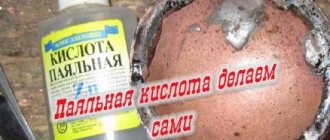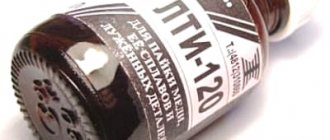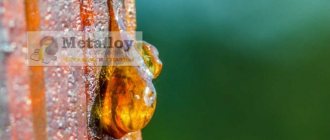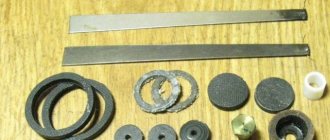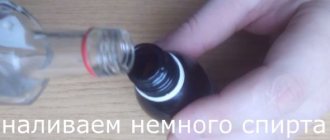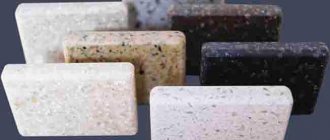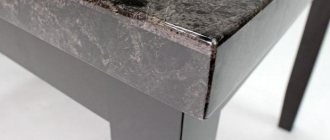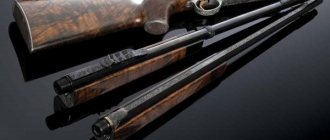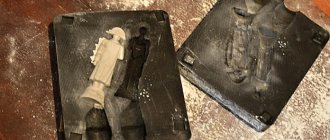Rosin does not always help to properly solder parts to each other, and then soldering acid comes into play, which can remove the oxide film from the surfaces and properly prepare them for soldering. If rosin flux copes well with the “duties” of preparing for joining elements made of copper, then acid compositions tin not only them, but also parts made of copper alloys (brass, bronze), stainless and black steel, nickel, precious metals and even aluminum or cast iron
Figure 1. Soldering acid is needed to remove the oxide film and prepare the surface of the part for soldering.
What are acid fluxes used for?
Acid provides the best environment for solder contact with parts over the largest possible area:
Figure 2. The structure of a salt battery.
- cleaning the treated surfaces from oxides and contaminants;
- protecting them from the resumption of the oxidation process;
- significantly reducing the surface tension of the solder, which allows it to flow more freely.
The result of this is a more reliable connection of the parts being soldered.
Different metals require the use of different soldering acids, but you should immediately understand that acidic fluxes should not be used when assembling circuit boards, because they are an aggressive environment that can have a destructive effect on all their components. In addition, acids are excellent electrical conductors, able to create additional (and unwanted) passage channels for current. You should not rely on neutralization of the acidic environment after soldering.
Why do you need an oxygen cylinder when welding?
Read about semi-automatic aluminum welding here.
Zinc chloride acid flux
Most often, flux is used to tinning parts to be soldered, which is freely sold in stores. Manufacturers, without further ado, call it “Soldering acid” (Fig. 1). In the annotations for the flux, they indicate the scope of its application. As a rule, this is soldering and tinning of copper, silver and various iron alloys, including cast iron.
The basis of soldering acid is zinc chloride compounds, that is, it is a solution of metal in hydrochloric acid.
Making soldering acid at home
Despite the availability of this active flux in stores, many home craftsmen are interested in whether they can make it themselves. Creating soldering acid is not particularly difficult. To make it you need:
- zinc (Zn);
- concentrated hydrochloric acid (HCl).
To obtain flux, its substances are added in the following proportions:
First, zinc is placed in a laboratory container (glass, ceramic, porcelain), and only then hydrochloric acid is poured into the container. It should be poured with extreme caution, and the level of HCl in the container should not exceed ¾ of its volume. After the completion of the dissolution reaction with the release of hydrogen (cessation of the formation of bubbles in the liquid) and clarification to transparency, the finished composition is poured into another tightly sealed container. Hydrochloric acid and granulated zinc are sold in chemical stores, but the metal reagent can also be obtained from used salt batteries (pen-AA batteries) of types “AA”, “AAA”, etc. (Fig. 2).
When preparing active flux yourself, you must take precautions. In laboratory conditions, the reagent is prepared in special cabinets equipped with an exhaust hood. At home, you should use protective equipment for your skin, respiratory system, and eyes. It is better to dissolve zinc outdoors or in a heavily ventilated room, since the reaction actively releases hydrogen. The reagents to produce zinc chloride should be mixed near a water source.
Scheme for washing eyes from flux.
If acid gets on your skin or eyes, the reagent should be washed off with plenty of running water.
A substance spilled on any surface is washed off with a solution of water with an acid-neutralizing alkali (baking soda). A few words should be said about the storage of hydrochloric acid.
Containers with it should be tightly closed and kept in a dark and cool place. Children should not have access to acid.
Pure hydrochloric acid can also be used as a flux. It is used to prepare for soldering iron parts (for example, roofing).
Physico-chemical properties and composition
Before making soldering acid, you should familiarize yourself with the composition of the material. This substance includes:
- Hydrochloric acid;
- Ammonium chloride;
- Zinc chloride;
- Deionized water;
- Wetting additive.
Soldering acid at home may have other components in its composition. The main thing is to achieve the required properties that this flux has. Firstly, there must be a high activity of the material. Rapid interaction with the elements makes the environment aggressive and destroys almost all harmful substances that interfere with normal soldering. This has the side effect that small metal parts may be damaged if they come into contact with the acid. Active solder fat also has similar properties.
Phosphoric acid flux
Another common soldering acid is phosphoric acid (H3PO4). It successfully removes oxides from metal surfaces and protects them from the formation of new compounds with oxygen, which form a film on the metal that prevents parts from soldering. It is no coincidence that phosphoric acid is included in most products for anti-corrosion treatment of steel structures.
For soldering chromium and nickel alloys, acid is not used in its pure form. Almost 1/3 of the flux consists of ethyl alcohol. H3PO4 accounts for 32%, and rosin accounts for 6% of the composition. In other compositions for tinning and soldering, the volume of acid can reach almost 100%. Often, orthophosphoric acid is diluted together with zinc chloride, the mass content of which in the flux can range from 50% to thousandths of a percent. H3PO4 is used not only for joining parts made of nickel alloys, it is used for soldering products made of low-alloy steel and pure copper or its alloys.
Table of acid fluxes.
Orthophosphoric acid is part of the F-38 N active flux, which is used for soldering:
- alloy, low-carbon and medium-carbon steel;
- copper and its alloys;
- chromium-nickel alloys.
F-38 N is used for soldering in places with difficult access and protects the soldered parts from corrosion. It contains:
Phosphoric acid is explosion- and fireproof, but working with it and storing it must be carried out in compliance with all safety precautions. After contact with the skin or eyes, the substance should also be washed off with running water. The duration of washing is at least 10 minutes.
DIY making
With some knowledge, it is quite possible to make soldering acid at home. To do this you will need the following ingredients:
- Pure hydrochloric acid;
- Pieces of zinc, which can be purchased at a chemical store or taken from a disassembled AA battery;
- A small glass vial with thick walls.
The vial is filled with hydrochloric acid to ¾ of its volume. When zinc is added, a chemical reaction begins, during which hydrogen is released. Therefore, it is better to carry out such manipulations outdoors. Pieces of zinc are added until the reaction stops and a gray precipitate is formed.
The finished soldering acid should be poured into another container for storage and use.
Useful tips Connection diagrams Principles of operation of devices Main concepts Meters from Energomer Precautions Incandescent lamps Video instructions for the master Testing with a multimeter
Fluxes made from aspirin and salicylic acid
One of the craftsmen, not finding rosin or other flux in the house, thought of using ordinary aspirin to treat the elements before soldering. Acetylsalicylic acid tablets can be used to repair household appliances. True, when aspirin is heated, caustic vapors are formed, so you should work with acetylsalicylic flux in a ventilated area. One way to tinning is to sprinkle aspirin powder on the part. In another way, the wires are placed on a whole tablet and heated with a soldering iron.
VTS flux is produced based on salicylic acid, which is often used in electrical installations. This composition provides protection to welded parts from corrosion, so it is preferred when carrying out this type of operation. HTS is used for processing copper and its alloys, as well as elements made of precious metals. The flux contains:
- solution of salicylic acid and ethanol (C2H5OH) - 6.3%;
- triethanolamine - 6.3%;
- technical petroleum jelly - 63%.
Read also: Angular gearbox for PTO on walk-behind tractor
What does it consist of?
In general, soldering acid is called zinc chloride, but the composition of the substances used in practice is somewhat different. Most often, soldering is done using preparations based on hydrochloric or phosphoric acid with the addition of solvents.
Concentrated hydrochloric acid is not applicable because it corrodes the metal. For electronic circuits, acidic substances are not used, soldering using rosin or choosing another inactive flux.
One of the universal types of liquid flux can be considered soldering acid FCA, produced by chemical industry enterprises.
This drug contains:
- zinc chlorides;
- ammonia (ammonium chloride);
- hydrochloric acid;
- water purified from impurities.
At home, soldering acid is made by dissolving zinc in hydrochloric acid. To obtain satisfactory results, you need to know how to solder metals and alloys with soldering acid, and also strictly follow safety rules when working.
How to treat parts with acid
Liquid fluxes are applied to surfaces with a brush. In this case, a more accurate and uniform wetting of the elements to be soldered is ensured, so the brush should be included in any soldering kit. At the same time, as already written above, both more active fluxes and less active ones, to one degree or another, have a destructive effect on both the connected surfaces and the solder. If the flux is not removed at the end of the work, then on steel parts, for example, rusting processes will occur at a much faster pace.
To prevent this, after soldering, parts coated with flux must be treated with neutralizers. The simplest of them is water. To remove F-38 N, you don’t need to use anything other than it. Soda neutralizes well the effects of hydrochloric, orthophosphoric, and acetylsalicylic acid, as it is a base. After soldering, a soda solution should be applied to the parts, which is then washed off with water. Residues of VTS are removed with alcohol or acetone.
Every person who has had to work with radio electronics has repeatedly used a soldering iron to solve their problems, so he knows what the operating principle of such equipment is. But due to the unpleasant odor emitted when processing a structure using classic solder, as well as significant difficulties at different stages of operation, this technology is not in great demand and has a number of simpler analogues.
Rosin and Zinc Chloride Solder Paste
And although this substance is no longer related to acid, but to solder paste, it was still decided to consider its preparation. Solder paste based on rosin and 1% zinc chloride is used for critical soldering work.
This substance can be used to solder non-ferrous, ferrous and even precious metals. The product is easily applied to the surface of the metals being processed and is easily washed off with acetone after soldering work.
When preparing solder paste from rosin and zinc chloride, you need to take:
- Rosin - 16%;
- Zinc chloride - 4%;
- Technical Vaseline - 80%.
To wash off homemade solder paste, it is best to use acetone, and not ordinary water, as is the case in most cases.
Purpose of soldering acid
To make the upcoming soldering more productive, many welders use special substances - fluxes, with the help of which the solder spreads evenly over the soldering site. Among the main fluxes, rosin and soldering acid are distinguished. The first option is indispensable when soldering copper and silver, and acid is used in particularly difficult cases. How soldering acid works, the composition and other features of such a substance are the main questions that concern many inexperienced beginners.
If we highlight the main recommendations for successful soldering with acid, they will look like this:
- When choosing a suitable solution, you need to understand the type of metal or alloy. When soldering iron, including galvanized iron, a unique type of soldering acid is used, represented by a solution of zinc chlorate. Soldering of stainless steel is carried out using phosphoric acid for soldering, as well as multi-component fluxes. A material such as aluminum cannot be soldered , which is due to the lack of suitable fluxes capable of dissolving the oxide film of the material. Acid cannot be used for soldering printed circuit boards, as this increases the risk of the formation of corrosive elements and short circuits between conductors.
- If you intend to use soldering acid for your own purposes, you can purchase it in the form of a paste at the appropriate store. Nevertheless, many welders make their own soldering acid, claiming that such an action does not require any special difficulties. You need to take about 100 ml of hydrochloric acid, put pieces of zinc in it, for example, removed from batteries, and wait for the chemical reaction to complete, during which hydrogen will be released. Given this feature, it is better to conduct the event in a ventilated environment away from sources of fire. If the hydrogen bubbles stop rising, let the solution sit until clear, and then carefully pour it into the bottle. That's it, the highly effective soldering acid is ready.
Soldering acid made from alcohol and petroleum jelly
Homemade soldering acid made from alcohol and Vaseline is no less popular among craftsmen. This solder acid has low acidity and can be used for soldering non-ferrous and ferrous metals.
Solder acid contains not only alcohol and petroleum jelly, but also 3.7% zinc chloride. Like Vaseline and alcohol, these substances contain 85% and 1.4%, and both are mixed when preparing the acid.
Instructions for use
- Immediately before soldering, it is necessary to clean the surface with a file or sandpaper, which will avoid all kinds of contamination.
- Acid should be applied to the adhesion site, for which you can use a brush. Next, you need to cover the structure to be soldered with solder based on tin or its alloy. If the substance does not apply evenly, you will have to repeat the acid treatment again.
- In the next step, carefully solder the surfaces. When working with a heated soldering iron, do not forget about safety rules and try not to clutter the work area with materials that ignite very quickly.
- After completing the procedure, the acid should be neutralized using an alkali, for example, a soda solution, and then rinse the adhesion site to get rid of any remaining acid. In rare cases, acetylsalicylic acid plays the role of a flux, although its use requires a more complex approach.
Features of metal soldering
Silver
If you have ever worked with a soldering iron, then you know that soldering is a unique type of permanent connection of metal products using low-melting metal. The technology itself is selected taking into account the type of metals that are to be soldered, as well as the environmental conditions where the action will be performed. For example, processing printed circuit boards from some electronics and repairing silver jewelry are significantly different from each other.
When soldering this way, you should use a soldering iron, solder, and also a flux, which is colophonium.
The step-by-step instructions look like this:
- It is no secret that for soldering elements with a high silver content, solder is used, which contains about 60% tin and 40% lead, which can melt at a temperature of 180 degrees Celsius. Try to prepare solder, which will be indispensable for soldering electronic circuits. This product consists of thin tubes that are filled with resin and act as a flux.
- The surface that will be solderable must first be cleaned of any defects and irregularities that may appear when exposed to the oxide film. In this case, the heated solder can create an effective connection with the silver.
- The part in the soldering zone is heated to such temperatures that natural melting of the solder begins. However, at this stage, some difficulties cannot be avoided, which may be associated with insufficient power reserve of the soldering iron for sufficiently high-quality heating. When soldering silver products, it is important to protect the area from possible exposure to atmospheric oxygen. In this case, colophonium is used, which can create a protective film over the soldering area.
- As for soldering jewelry, it is carried out using high-temperature solders that correspond to the metal standard, or using solders of a lower standard, but containing silver. Soldering jewelry with tin is necessary only in the most extreme cases, and only after prior agreement on all details with the owner of the ring, chain, bracelet or other item. If you do not know how to perform such an action correctly, this can cause damage to an expensive structure.
Boards
It's no secret that soldering radio components into boards is a simple process . It is much easier to do than connecting loose wires, since the holes in the boards are intended to fix the soldered parts. However, you need to understand that the final result is directly related to the experience and responsibility of the worker. The first circuit that is assembled on a breadboard cannot be called very successful. But don’t worry - after some time the quality of the connections will increase significantly.
Read also: Wrench for grinder dimensions
Step-by-step instructions and features of such soldering consist of the following points:
- The main goal of the upcoming work is to effectively connect the chip to the board so that a uniformly good soldering is obtained. The event can be divided into several separate stages.
- First, you need to simultaneously bring the solder and the tip of an already heated tool to the area where the connection is required. It is important to follow the key rule, making sure that the soldering iron tip is in full contact with the pin being processed and the board itself.
- During processing, you cannot change the position of the soldering iron tip until the entire contact area is covered with an even layer of solder. In most cases, this takes from 0.5 to 1 second. This time period ensures sufficient heating of the soldering area.
- At the next stage, you need to circle the tip of the tool near the contact being processed in a semicircle, moving the solder in the opposite direction. In the same way, apply another millimeter of solder to the soldering area. During this period, the selected area will warm up quite well, so the solder melted under the influence of surface tension will be distributed evenly over the contact area.
- After successfully applying the required amount of solder to the selected location, you can move the wire away from the soldered area.
- And at the last stage, you should quickly remove the tip to the side. In a short period of time, the liquid substance, with a small layer of flux, will take its final shape and harden, creating a strong connection.
It is important to understand that if the sting is sufficiently warmed up, the action will not take more than 1 second. Try to hone your skills and follow the recommendations of professionals. This way you can achieve incredible success.
Every man can learn to solder, because this procedure does not require any special skills or secrets. In any case, the ability to solder can be very useful and useful in everyday life, where you need to connect wires and parts of electrical circuits, repair a car radiator, and also install copper pipeline elements.
It's no secret that copper is one of those materials that lends itself very well to soldering. In addition, the surface of products made of this metal can be easily cleaned from oxide film, dirt, unevenness and other defects without the use of expensive chemicals and aggressive agents. Most fusible metals have excellent adhesion to copper and do not require the use of expensive or complex fluxes. Copper practically does not interact with air when heated.
Due to such unique properties , metal can be soldered in a wide variety of environmental conditions, using various types of fluxes and solders.
To solder parts, you should use electric soldering irons or soldering stations with different power. It is known that the greater the mass and volume of the part, the higher the power indicators of the working tool should be. If you've never soldered before, a 25-50W device might be your best bet
Type and composition of soldering acid
Orthophosphoric acid
It is an inorganic compound that has a characteristic average strength of action. The formula of this composition can be written as H3PO4. In most cases it is colorless, less often found in the form of a solution with a light yellow tint. The main features of the substance include its ability to transform into a pyrophosphorus cyst (H4P2O7). When a substance is exposed to water, ethanol and other solvents, it dissolves. This composition contains zinc chloride in the amount of about 50%. Also acceptable is insoluble sediment in a proportion of 0.001%, and ammonia no more than 0.5%.
Sulfuric acid
The composition of sulfuric acid can be expressed in the formula H2SO4. In appearance it is a gray oily liquid that is odorless. Before soldering, the substance must be diluted with water or sulfuric anhydride SO3. The use of this dibasic substance is widespread in various fields.
Other soldering features
At the learning stage, many beginners have a question: “what is solder and flux.” Solder is a common form of low-melting metal that is required for successful soldering of radio circuits, electronic components, and jewelry. Most often, solder is made from tin, but in its pure form such metal is not cheap, so it is used only for tin-plating and soldering of utensils, which are used for storing and preparing food. If it is necessary to solder wires and electrical circuits, the tin-lead solder option is used.
When performing soldering work, you may need the following tools and accessories:
- stand for soldering device;
- side cutters;
- pliers;
- tweezers;
- stationery knife;
- vice;
- desoldering pump or copper braid.
The soldering process itself includes several steps:
- Cleaning the selected area to a shine.
- Dipping the soldering iron tip into rosin for more effective cleaning.
- Firmly pressing the connected elements together.
- Then it requires applying a soldering iron with a small amount of solder at the end to the junction of such parts.
- Next, you need to run the soldering iron tip along the part or wire, doing this as quickly as possible to avoid burning out the rosin on the tip.
- The soldering area should be thoroughly heated so that the rosin, when melted, covers the entire surface of the part, and the solder fills the gap between the parts.
- Be sure to remove excess solder with a soldering iron or desoldering iron. It also wouldn't hurt to use braid.
If all operations are carried out exactly according to the established rules, the hardness of the solder will become maximum, and its distribution will be uniform.
If during the solder solidification stage the soldered parts move from place, most likely the soldering is not good enough. To avoid such a course of events, it is enough to learn how to avoid making many mistakes.
What is rosin and other fluxes used for?
The fact is that, unlike welding, joining with solder requires more careful preparation of the surfaces to be joined. Molten solder behaves like an ordinary liquid.
If the surface tension of the melt is higher than the adhesion, the liquid metal simply will not “stick” to the part, but will remain on its surface in the form of a ball.
Why is this happening? Oxides form on the surface of any metal. This thin film prevents the metals from making normal physical contact. Of course, the surface can be mechanically cleaned before soldering.
But when heated, the oxide film will instantly cover the prepared surface. Flux works against this effect. In addition to their cleaning function, fluxes create a protective film on metals that prevents the formation of oxides.
But these “helpers” do not interfere with solder adhesion. On the contrary, it only intensifies with the use of fluxes. The result is a strong connection with excellent electrical conductivity.
When working with copper, silver, silver-plated or gold-plated contacts, you can get by with rosin made from the resin of coniferous trees.
Read also: Crafts from a glue gun for the New Year
But this drug has significant disadvantages:
- Rosin begins to melt when heated (the usual state is crystalline). Accordingly, the contact sometimes has time to oxidize.
- Low cleaning abilities do not allow working with metals whose oxide film is too strong: aluminum, stainless steel. When soldering, it is necessary to use chemically active fluxes.
In some cases, the oxide layer can be “broken” only with the help of acid or preparations containing it in their composition. Soldering acid can be universal or used with specific metals.
The composition of soldering acid (in addition to the main component) includes thickeners, neutralizers, oxide converters, and other chemicals. However, acid-based fluxes are available on the market at relatively low cost.
Unfortunately, many manufacturers do not indicate the composition on the label, limiting themselves to the inscription “soldering acid”. When purchasing such compositions, inexperienced craftsmen are faced with incompatibility between the flux and the metal being processed.
For example, stainless steel soldering acid does not treat copper contacts well. And the composition that is used for copper and silver is not suitable for aluminum parts.
Therefore, many radio amateurs prefer to use homemade compositions. Do-it-yourself soldering acid is made from available materials.
An experienced soldering specialist can select the proportions in such a way that the effectiveness of the preparation will be higher (for specific soldering cases).
What can you do at home?
The degree of acidity of fluxes differs.
Active mixtures include compositions with zinc chloride. From the school course, perhaps someone remembered the properties of saline solutions. Salts tend to undergo hydrolysis in the presence of water. Zinc chloride, when exchanged with water, forms a strong acid and a weak alkali. Therefore, the solution has an active acidic character. Hydrochloric acid quickly removes oxide substances.
Typically, soldering acid is made by adding 412 g of zinc to 1 liter of concentrated hydrochloric (hydrochloride) acid. The procedure is not entirely pleasant and safe. During operation, volatile acidic vapors are released.
You should work with concentrated hodgepodge only under a hood or in a respirator, in a well-ventilated room.
With hydrochloric acid
Several formulations with zinc chloride are popular. Zinc compounds are used in the galvanizing process to protect metals from corrosion. This chemical element is known for its resistance to oxidation processes. Making soldering acids with your own hands is not difficult.
For products made of ferrous and non-ferrous metals, the following ratio is suitable:
- zinc chloride – minimum 25%, maximum – 30%;
- concentrated hydrochloric acid – 0.7%.
Both components must be quickly dissolved in water. It should be noted that hydrochloric acid is a highly volatile substance. It is advisable to work with it under a hood. The bottle with the starting reagent should only be kept closed.
With Vaseline and alcohol
For parts made of ferrous and non-ferrous metals, sometimes it is more convenient to use a paste with acidic properties instead of soldering acid.
To prepare it, you need to mix a saturated solution of zinc chloride - 3.7% and technical petroleum jelly - 85%. To give the required consistency, add a little water to the mixture.
To work with nickel, platinum and their alloys, you can make a soldering mixture with your own hands from zinc chloride - 1.4% and ethyl (wine) alcohol - 40%. Both components must be thoroughly dissolved in water and the finished soldering solution must be mixed.
After using all the above compounds, the soldering area should be rinsed well with plain water.
With rosin
For carrying out critical work with ferrous metals, soldering precious and non-ferrous metals, a paste mixture made by yourself from rosin - 24% and zinc chloride - 1% is suitable. All this must be dissolved in ethyl alcohol. At the end of the soldering procedure, you need to wash the work area with acetone.
To form a seam with increased strength characteristics, it is recommended to take:
- rosin – 16%,
- zinc chloride – 4%,
- technical petroleum jelly – 80%.
It is more difficult to rinse the soldering area after treating it with such homemade solder paste. You need to take acetone.
Experience shows that in some cases it makes sense to replace soldering acid with a corresponding acidic paste.
Homemade sour pastes
When working with aluminum parts, a flux with oleic acid is often used, the formula C17H33COOH gives an idea of the high molecular weight. Higher acid has a viscous consistency, similar to a slightly viscous liquid.
Soldering flux is made as follows: 20 ml of oleic acid, about 3 g of lithium iodide are dissolved in a glass container in a water bath. A homogeneous solution, made with your own hands, after cooling, is poured into a glass bottle for storage.
After soldering, the working area is washed with acetone, gasoline or alcohol.
To solder nichrome, you can make a composition with your own hands from 100 g of Vaseline, 7 g of powdered zinc chloride, 7 g of glycerin.
The whole mass must be mixed well. It is advisable to do this in a thick porcelain cup or a special mortar.
Types of soldering acids and application features
In order not to spoil the product, and at the same time get a high-quality oxide cleaner, you need to know what each soldering acid is needed for.
If you don't know how to use soldering acid correctly, you can end up with a time bomb. The PCB traces, or wire connection, will slowly deteriorate when exposed to the corrosive component.
At the most inopportune moment, the connection will disintegrate. The second version of the problem is that the use of an incorrectly selected acid leads to the formation of a thin dielectric layer at the soldering site.
The strength of the connection may be high, but the electrical conductivity parameters will be impaired. This contact will become the weak link of the entire circuit. Finding the fault is quite difficult.
It is undesirable to replace soldering acid for a specific metal with a composition based on another active element.
Zinc chloride flux
Used for soldering iron. From the point of view of a school chemistry course, this is pure zinc dissolved in hydrochloric acid: that is, a solution of zinc chloride.
Actually, this is how it is produced: a solution of hydrochloric acid (or a concentrate, depending on the technical specifications) is added to a container with granulated zinc, a chemical reaction takes place, and the composition can be used.
Classic flux recipe: 400 grams of pure zinc per 1000 ml of concentrated acid.
Please note: A glass or ceramic container is used. The acid is added to the zinc, not the other way around. During the reaction, hydrogen is released, which, when mixed with oxygen from the air, forms an explosive mixture (not to mention the fact that the gas itself is flammable). Therefore, the production of zinc chloride flux is organized in a well-ventilated area.
After use, the surface should be treated with an alkaline solution to stop the reaction. For example - soapy water.
Oleic acid
An indispensable composition for soldering aluminum. It is not used in its pure form. Actually, it does not exist in its pure form. The so-called technical olein is used.
To maintain the stability of the substance, oleic acid is mixed with other fatty acids. The resulting mass is mixed with lithium iodide, and an ideal flux for aluminum alloys is obtained.
Why do you need soldering acid when soldering aluminum? The layer of oxide film on this metal is practically unkillable. When stripped mechanically, a new film immediately grows.
Technologists have been looking for something to replace acid for many years. The main task is to protect the soldering area from exposure to oxygen.
No other flux is suitable in place of soldering acid, but you can mix iron filings with machine oil and rub the joint point while heating and adding solder.
Olein flux performs two tasks at once: it dissolves the oxide film (which is very difficult), and preserves the protective layer until the end of soldering. When heated, the acid evaporates, but the soldering area is already securely tinned.
It is impossible to make olein-based soldering acid at home. But flux is inexpensive and always available.
Orthophosphoric acid
Perhaps the most common acid flux. The main application is soldering iron, steel contacts, and nickel-containing alloys. This flux is also good for soldering pure copper (especially if the contact area is too large).
After removing the oxides, the flux covers the metal with a durable elastic film that prevents further oxidation. When you touch the soldering iron tip, the protective film evaporates, allowing the solder to adhere.
How to use soldering acid correctly
After soldering is completed, the flux-treated metal does not corrode. Depending on the selected metal, different proportions of components are used.
Phosphoric acid is mixed with ordinary rosin, ethyl alcohol, and even zinc chloride. Basically, additives are added when creating fluxes for soldering chrome and nickel compounds.
To work with other metals, the share of the acid itself reaches 100%. If you manage to find the acid in its pure form, you can make any flux yourself by adding available components.
Professionals do this, especially since almost any combination of metals can be soldered with orthophosphorus, except perhaps aluminum.
Flux VTS
The basis of the drug is salicylic acid. The same one used in aspirin tablets. Flux is used for working with copper and precious metals (including silver-plated and gold-plated contacts).
The main advantage is excellent protection of the soldering point from oxidation. Flux can (and even should) not be removed unless there are aesthetic requirements for the work.
Cheapness and versatility of use could make this flux the most popular. The exception is the same aluminum. However, the emissions from heat treatment are so caustic that an exhaust hood is required for operation.
This limits the home use of the drug. However, with normal ventilation, you can even use self-made flux.
The easiest way: grind an aspirin tablet and sprinkle it on the adhesions. When tinning the ends of the wire, just put the bundle on the tablet and press it with a soldering iron.
More convenient formulations are made based on technical petroleum jelly. It is mixed with the powder in a ratio of 1 to 2, and the composition can be applied to the soldering surface.
Bottom line: There are no absolutely universal acid-based fluxes. Each composition works better with one metal or another. You will find information on how to use acids on the label.
When making flux yourself, safety issues also come first. The general rule is to add acid to the rest of the ingredients, not the other way around. Washing parts after processing is not always necessary; in some cases, the acid composition, on the contrary, protects the soldering area.
Pros and cons of soldering acid
The solution has a number of undoubted positive properties:
- eliminates almost all oxides formed on metal structures;
- prevents the re-formation of oxidative plaque;
- used in a dissolved substance, but can also be used in concentrated form;
- simple technology of use, characterized by a quick effect on the metal.
Of course, there are also disadvantages:
- Not all materials can be soldered with acid, since the substance is very aggressive;
- the acid retains its properties for no more than six months, and during this time it is necessary to follow storage rules;
- store in special containers in rooms with excellent air circulation - direct contact with the substance without protective equipment is very dangerous for the human body.
Soldering acid is widely used when soldering miniature small objects, as it is available in liquid form.
